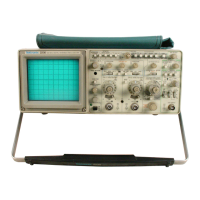ADVANCED FUNCTION MENU
{for the 2230 only)
The
following functions
are
available
as
part of the
ADVANCED FUNCTIONS Menu
on
2230 instruments con-
taining either the GPIB or the RS-232-C option.
REFERENCE-Allows a non-volatile SAVE
REF
memory to
be
copied, deleted, or protected.
COPY-Selects
and
copies one non-volatile
SA
VE
REF
memory to another SAVE
REF
memory.
Waveforms stored
in
the lettered extended memory
locations
(REFA
through
REFZ)
must
be
moved to
one of the numbered SAVE
REF
memory locations
to
be
displayed. Waveform data to
be
retrieved
from or written to
an
extended memory location
must go through a numbered SAVE
REF
memory.
DELETE-Selects a non-volatile SAVE
REF
memory
and
erases the stored data if not locked.
PROTECT
-Selects
memory space to lock or
unlock. Locked memory locations cannot
be
overwritten or deleted. Via the Communications
interface, extended memory locations
may
be
per-
- - manently protected to prevent them from
being
overwritten
by
the UNLOCK or
DELETE
menu
functions.
COMM-Allows the selection of parameters for
optional communications options, when they
are
present.
DATA-Selects the data-coding format (ASCII,
HEX,
or BINARY), source or destination target of
the data
(ACQ,
REF1,
REF2,
REF3
or
REF4),
and
channel selection
(CH1
or
CH2)
for
data transmissions.
STOP
BITS-Selects
the number of stop bits for
RS-232-C data transmissions. (Stop bits
are
selected
by
interface command
in
the 2220
and
2221.)
The
usual choice for stop bits
is
1,
but some
printers/plotters require two stop bits for some
baud rates.
FLOW-Sets
the data flow control over the inter-
face
ON
and
OFF.
Binary waveform information
cannot
be
sent with
FLOW
ON.
Options and
Accessories-2230
Operators
NON-VOLATILE EXTENDED MEMORY
{for the 2230 only)
When
either Communications option
is
installed
in
the
2230
DSO,
extra battery-backed memory
is
also installed.
Waveforms stored
in
the extra memory may
be
protected
from overwriting or deleting (locked) using the Advanced
Functions
menu.
Commands that
are
available via the
communications interface
can
also lock that memory
space. Memory spaces may
be
also made "permanent" via
the Communications interface. Permanent waveforms
cannot
be
overwritten, unlocked, or deleted
by
the opera-
tor with the Advanced Functions
menu.
The
extra memory provides
26
Kbytes of non-volatile
waveform storage space. The memory
is
divided into
1 Kbyte locations labeled
REFA
through
REFZ,
but the
number of actual waveforms that may
be
stored depends
on
the acquired waveform record length (1024 bytes or
4096 bytes)
and
acquisition mode (normal or average).
Averaged waveforms require two bytes for
each
point so
that
an
averaged 1 K waveform needs 2 Kbytes of non-
volatile SAVE
REF
storage
and
an
averaged 4 K
waveform needs 8 Kbytes. Specifications for the non-
volatile Extended Memory
are
given
in
Table 7-1.
OPTION 10 GPIB
OPERATORS INFORMATION
The
GPIB Communications Option complies with
ANSI/IEEE Standard 488-1978.
All
other specifications for
the instrument (including the performance conditions)
are
identical to those specified
in
"Specification"
in
Section 1
of this manual.
Standard Functions, Formats, and Features
The
interface-function capabilities of a GPIB instrument,
in
terms of interface-function subsets,
are
identified
in
ANSI/IEEE Std 488-1978.
The
status of subsets applicable
to this instrument with Option
10
are
listed
in
Table 7-2.
The
GPIB
interface conforms to the Tektronix standard
on
Codes, Formats, Conventions,
and
Features of
messages sent over the
bus
to communicate with other
GPIB instruments. Specific format choices implemented
in
this instrument
are
listed
in
Table 7-3; specific features
implemented
are
shown
in
Table
7-4.
7-3

